project12:W3MSc1TUDG2:MEDIA
MSc1 TUD: G2
MEDIA STUDIES
- D2RP&O RESEARCH
- LECTURE 1: ENVIRONMENTAL INTERACTION
- LECTURE 2: 3D PRINTING WITH PLASTIC
- LECTURE 3: JELLE FERINGA
- W2 @ DIA
- W3 @ TUD
- PROJECTION AND FUTURE GOALS
1. D2RP&O RESEARCH
We began our research by searching for different references of urban furniture and parametric design, specially of examples that had a relationship to water and nature in order to reinforce our guiding concept of an object that could serve both humans and insects. We also looked up for references of materiality, hybridity and assembly, for all of these would inform the production method we would finally use. Additionally, we researched human anatomical factors and insects necessities to produce an object that conformed to them. Many of our sources and examples came from the lectures we attended and from projects from previous TU Delft students in the Hyperbody studio.
2. LECTURE 1: ENVIRONMENTAL INTERACTION
The first lecture in the media studies series was related to the possible ways to map users activities and their interaction with their environment in innovative ways. We applied this idea and format to explain the encounter between the users and our objects.
3. LECTURE 2: 3D PRINTING WITH PLASTIC
The second lecture was about a PHd research on the flexible potential of recycled plastic as the base for 3D printing and the role of the final users in the process itself. There was an emphasis on the circularity of the material and on the harmful effects of environmental contamination when plastic is discarded instead. The most interesting example was a 1:1 prototype of a 3D printed chair that was later located in different public spaces in Rotterdam. The interaction between the object and the users was mapped and recorded, showing the positive response of the people around it. We found both the production method and user interaction applicable to our proposal.
